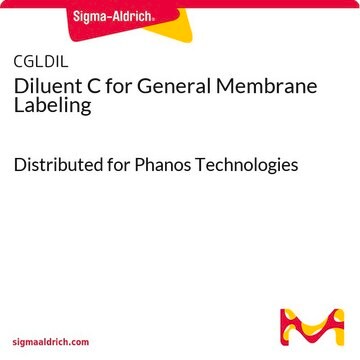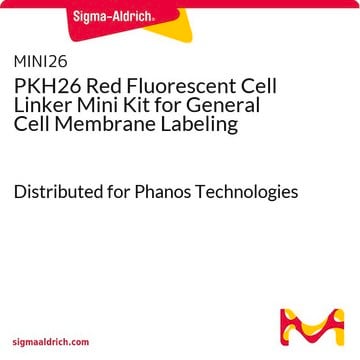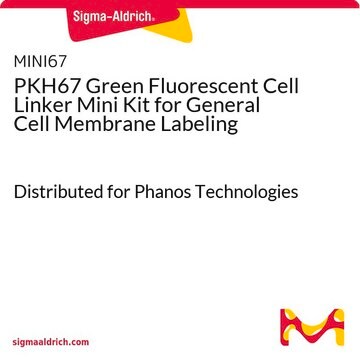BioTracker™ Membrane Dyes are lipophilic carbocyanine dyes. Lipophilic carbocyanine dyes have been used to stain neuronal cells in culture for several weeks, and in vivo for up to a year. The dyes do not appreciably affect cell viability and do not readily transfer between cells with intact membranes, allowing cell migration and tracking studies in mixed populations. The stability of labeling may vary between cell types, depending on rates of membrane turnover or cell division. Please see the link below to review the product datasheet:
https://www.sigmaaldrich.com/deepweb/assets/sigmaaldrich/product/documents/258/959/sct109ds.pdf
SCT109
Colorante Azul para membrana citoplásmica BioTracker 400
Live cell imaging lipophilic carbocyanine membrane dye suitable for long-term fluorescent cell labeling and cell tracking studies.
Sinónimos:
Live cell imaging probe, Live cell membrane dye
About This Item
Productos recomendados
técnicas
cell based assay: suitable
método de detección
fluorometric
Descripción general
A diferencia de los colorantes PKH, los colorantes de membrana citoplásmica BioTracker no requieren un complicado protocolo de marcado hipoosmótico. Son disoluciones colorantes listas para usar que se pueden añadir directamente a los medios de cultivo normales para marcar las células suspendidas o adherentes en cultivo.
Propiedades espectrales
Absorbancia: 366 nm
Emisión: 441nm
Aplicación
Obtención de imágenes celulares
Tinción de células vivas
Componentes
2. 1 vial de 250µl de tampón de carga (CS224587)
Calidad
Absorbancia: 366 nm
Emisión: 441nm
Forma física
Almacenamiento y estabilidad
Nota: centrifugue brevemente el vial para recoger el contenido en el fondo del vial antes de abrirlo.
Cláusula de descargo de responsabilidad
Código de clase de almacenamiento
12 - Non Combustible Liquids
Punto de inflamabilidad (°F)
Not applicable
Punto de inflamabilidad (°C)
Not applicable
Certificados de análisis (COA)
Busque Certificados de análisis (COA) introduciendo el número de lote del producto. Los números de lote se encuentran en la etiqueta del producto después de las palabras «Lot» o «Batch»
¿Ya tiene este producto?
Encuentre la documentación para los productos que ha comprado recientemente en la Biblioteca de documentos.
-
After the staining, I am planing to culture the cells about a week and do imaging. For how many days would the cells be stained? After the cell division, would the flouresence be approximately halved and would both cells be florescent?
1 answer-
Helpful?
-
-
Hi, How necessary is placing the coverslip or chamber slide in a humidity chamber? I tried staining adherent cells in a glass bottom dish following the steps excluding the humidity chamber and was unable to get clear results.
1 answer-
Placing the coverslip or chamber slide in a humidity chamber is necessary to help maintain a moist environment during the staining process. It helps to prevent the drying out of the cells and the staining medium, allowing for better diffusion and interaction between the labeling solution and the cells.
Helpful?
-
-
Does it stain bacterial membrane?
1 answer-
This product is a lipophilic carbocyanine dye intended for use in plasma membranes and cells. The uptake is dependent on the lipid bilayer. It is not tested for the suitability of bacterial membrane, however given the make up of the bacterial cell wall it is unlikely.
Helpful?
-
-
Is this dye compatible to image live migrating HL60 cells?
1 answer-
This product is suitable for live cell imaging. The HL60 cell line has not been specifically tested, however there is no reason to expect it will not work. While this stain is markely more photostable that DAPI and other similar dyes, the retention time has not been determined. The addition of verapimil is recommended to improve retention time. See the link below for the product data sheet. The protocol can be found on page 2.
https://www.sigmaaldrich.com/deepweb/assets/sigmaaldrich/product/documents/258/959/sct109ds.pdfHelpful?
-
Active Filters
Nuestro equipo de científicos tiene experiencia en todas las áreas de investigación: Ciencias de la vida, Ciencia de los materiales, Síntesis química, Cromatografía, Analítica y muchas otras.
Póngase en contacto con el Servicio técnico




